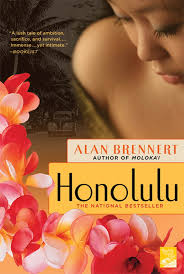 I first read Honolulu several years ago, and this is the novel that sparked my interest in Hawaii. Before I read it, my mental picture of Hawaii was hulu, surfing, mainland American honeymooners, and the last Hawaiian queen (also through reading), I didn’t realize quite the influence of Japanese, Korean and Chinese immigrants on Hawaiian life. This got me reading a lot more about Hawaii… which eventually led me to spend a month working on Oahu.
I first read Honolulu several years ago, and this is the novel that sparked my interest in Hawaii. Before I read it, my mental picture of Hawaii was hulu, surfing, mainland American honeymooners, and the last Hawaiian queen (also through reading), I didn’t realize quite the influence of Japanese, Korean and Chinese immigrants on Hawaiian life. This got me reading a lot more about Hawaii… which eventually led me to spend a month working on Oahu.
Jin, nicknamed Regret in a family that prefers sons, leaves her village in Korea and makes her way to Hawaii with a group of other picture brides. They’ve been promised to Korean men, but that’s just about the only thing that’s true about their husbands-to-be. Jin dreams of prosperity and romance in Honolulu, but her husband isn’t exactly a prince. She also dreams of earning enough money to rescue Blossom, a little girl promised as a small wife to Jin’s brother, and bring her to Hawaii. Although Jin has years of hardships and challenges in her new home, the story is ultimately uplifting and filled with the ohana spirit. Her Korean picture-bride girlfriends, Hawaiian Joe and Esther, and their complicated family, Jin’s second husband and children (spoiler alert!), and even her Japanese neighbors are all part of her ohana by the end of the novel.
I loved the mix of exotic, beautiful Hawaiian landscape and Jin’s personal adventures. Sure, Oahu a land of sunshine and bright flowers, but for a lot of the book, Jin is working in the pineapple-canning factory or sugar cane fields, not chilling at Waikiki. Since I was working pretty long hours myself on Oahu, I found myself thinking about this novel a lot. Being a worker in a place where everyone’s on vacation is a strange feeling. I mean, I had time to vacation afterwards, and that’s how I funded my trip, and I’m lucky to get to do that, but it’s a strange feeling to be working in a holiday destination.
Later, when I was done with classes, I went to stay in Waianae. When I was taking the bus from Waianae, I saw the old train tracks running between the bus route and the ocean, and I realized I was on Jin’s path. The bookish traveler’s dream. (There’s no train on Oahu, which blows my mind. There once was needed infrastructure! The tracks are still there! But you can’t take a train! You have to sit in traffic next to the train tracks!)
When I read, I bookmarked basically every place where Jin went to eat that was still around. I would have gone to try malasadas, masubis, and Hawaiian fusion meals anyway, but it was extra fun to do it after reading about them.
